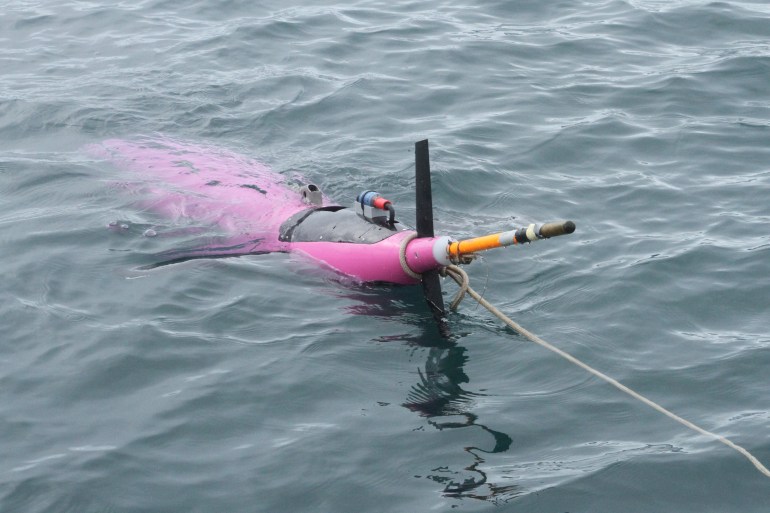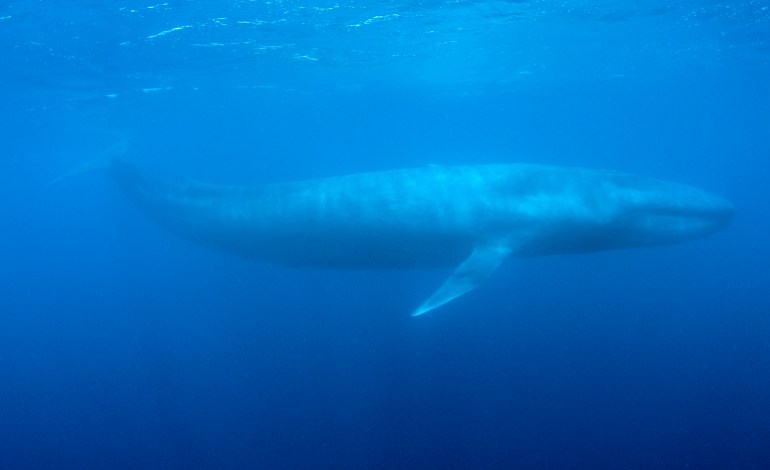Deep and dangerous: Is AI the future of ocean exploration?
The Titan implosion has cast focus on autonomous, unmanned submersibles as the way to uncovering the ocean’s secrets.

When the Titan submersible, carrying five sightseers to the wreck of the Titanic, blew up thousands of metres under the ocean surface in June, it underscored why humanity knows more about the surface of some other planets than about the depths of the Earth’s oceans.
Oceans cover more than 70 percent of the earth’s surface. Yet, this underwater world is a challenging place to explore, as the Titan disaster showed. It’s a vast space. The deepest point under water, the Challenger Deep in the Pacific Ocean, is 11,000 metres deep, more than the height of Mount Everest.
Keep reading
list of 4 itemsCould shipping containers be the answer to Ghana’s housing crisis?
Are Chinese electric vehicles taking over the world?
First pig kidney in a human: Is this the future of transplants?
The light doesn’t penetrate to such depths. Still, that little-known world is crucial for the future of the planet. The oceans interact heavily with the earth’s climate and understanding them better could offer potential solutions to climate change. New animal and plant species are also constantly being discovered in the great deep.
The ocean bed is also home to battery metals such as cobalt, copper and manganese which are critical for the planet’s clean energy transition. And a race to the deep sea is on, with companies and countries eyeing resource deposits on the seabed to mine, even as environmentalists have warned of damage to vulnerable ocean ecosystems.
Norway’s government wants to open up an area of the ocean floor larger than Germany for mining. India, which in August became the first nation to land a spacecraft near the moon’s South Pole, has announced a mission called Samudrayaan – sea vehicle in Sanskrit – for a submersible with three people to travel to a depth of 6,000 metres by 2026. China is building an icebreaker with a submersible that aims to reach and explore the Arctic seabed.
Is it too dangerous to explore these depths? Where does the technology stand? And what’s next for submersibles?
The short answer: Underwater exploration will most likely continue, even after the Titan debacle. However, small submersibles, often uncrewed and driven by artificial intelligence (AI), might be the future, using novel technology to recharge under water and operate for months – even years – on end. Before we accomplish that, though, some technological hurdles still remain.

Unmapped depths
While decades of scientific and technological advances have allowed humans to send exploratory missions to distant planets, only about 25 percent of the Earth’s ocean floors have been mapped to date.
Still, that too represents a major shift: By 2017, only 6 percent of the ocean floor had been charted.
“So, the last few years we have seen a huge acceleration. Nevertheless, there’s still a long way to go,” said Jamie McMichael-Phillips, director of Seabed 2030, an initiative that aims to map the entire seabed by 2030.
Seabed 2030 doesn’t usually do this mapping itself. It scours archives of governments, research institutes and companies looking for seabed maps that haven’t been published yet. Besides that, it tries to convince other ships to use their sonar systems to map the seafloor and share that data with them.
Sonar is an old technology, first invented in the 1910s. It uses sound waves to determine what is under water and what the seabed looks like. With this technology, a surface vessel can roughly map even the deepest points of the ocean. Seabed 2030 turns data like this into a map and makes it public.
“There are a range of ocean processes that depend on the shape of the ocean floor,” said McMichael-Phillips. “We need this information to better understand climate change and issues of biodiversity.”
What is challenging about the process is that it is slow and time-consuming. Fully crewed ships need to sail across the world and use their sonar to scan the ocean floor.
“It’s a slow, slow process”, said McMichael-Phillips. “The game changer will be uncrewed technology, where you can operate a vessel almost 24/7, without any people on board.”

AI is ‘the future’
This is why ocean researchers have big hopes for artificial intelligence. Seacraft, such as submersibles, that operate autonomously by themselves, could take away a lot of the manpower needed to explore the vast reaches of our oceans.
“A remotely operated underwater vehicle, controlled from a distance by a human pilot, works well when you need to inspect a specific object, like the base of an offshore wind turbine,” said Helge Renkewitz, a researcher at the German research institute Fraunhofer working on underwater robotics. “But if you want to explore large stretches of the seafloor, autonomous vehicles are the future.”
Autonomous, AI-powered submersibles would minimise the risks to human lives from deep-sea exploration and would allow faster mapping of ocean floors. But what researchers ideally want is to go one step further: build submersibles that can explore for indefinite stretches of time, thereby speeding up the process of scanning the planet’s deepest spots.
That, according to Renkewitz, is difficult because the deep sea comes with several engineering challenges.
First, there’s the corrosiveness of salt water, which makes it hard for submersibles to survive undamaged for long unless they are made of high-tech materials like titanium steel. Then there’s the pressure. The deeper you go under water, the more pressure is directed at an object. This proved fatal for the Titan submersible.
“At the depth of the Titanic wreck, almost 4,000 metres deep, a craft experiences 5,689 pounds [2,580kg] of pressure per square inch,” said Renkewitz. That’s 400 times the average pressure we experience at sea level.
And then there are the challenges that autonomous vehicles face in navigating the terrain deep under water.
On the surface, a self-driving car can use sensors to look around and recognise things. It can also rely on precise satellite positioning systems like GPS. An autonomous submersible doesn’t have these luxuries.
Because of negligible light deep in the ocean, it can only see very close to itself. Sonar can help it see further, but it can only detect objects in a very specific direction. On top of that, finding its own position is very difficult for a submersible because of the lack of satellite connections under water. Researchers use complex calculations to keep track of where a craft is, but those aren’t always accurate.
“There’s always an error rate in these position estimation algorithms,” said Renkewitz. “And the longer you spend under water, the worse the error gets. After only a few hours, you can be hundreds of metres away from where you think you are depending on the quality of your sensors.”

Perpetual exploration
Another challenge for long-term submersibles is energy. These craft need electricity to operate, yet under water, there’s no obvious source of power to use. According to Paul Koola, professor of ocean engineering at Texas A&M University, solving this issue will be one of the keys to exploring the deep sea more intensely.
“The dream would be to have a perpetually operating vehicle that uses renewable energy to monitor the ocean and continuously inform us of any changes,” he said.
Some submersibles have taken steps towards this vision. Underwater gliders absorb water to make them glide downwards and release it again to go up, steering themselves with wings. In this way, they can bob up and down across the ocean for months. But even they are eventually limited by their battery life.
To move past this, several options are available. Even though the sun doesn’t penetrate far under the surface, an autonomous submersible could surface regularly to stock up on energy before it goes down again. But the small size of a submersible would limit the amount of solar power it can gather, according to Koola.
Floating charging stations across the ocean, where submersibles could dock and recharge, are another scenario researchers are considering. The problem? This would need a high start-up investment.
“The initial ramp-up is very slow,” said Koola. “You need an Elon Musk-type character to make this happen and standardise power charging connectors at sea.”
Another option could be to use ocean currents or hydrothermal vents on the seabed, although these are not always available everywhere. Koola is also working on a system to generate energy from the heat differences between water at different depths. A craft could, in this way, go down and up in the water and generate the power needed to sustain itself.
Making any such mechanism work in the harsh conditions of the ocean won’t be easy. Nevertheless, Koola is optimistic.
“The time seems to be right,” he said. “Interest and funding is increasing, and technology is advancing. That being said, if we would fund deep-sea exploration like we fund space, we would be much farther already.”

Shrimp saviour?
What these future, autonomous submersibles might look like is changing as well. At Brown University, a team is now looking at how some sea animals, such as shrimp and krill, might serve as an inspiration for future swarms of underwater craft.
“We want to understand why krill and shrimp are so good at manoeuvring, accelerating and braking,” said Sara Oliveira Pedro Dos Santos, a PhD student who is part of the team. “These are all qualities we want in a submersible to explore the ocean, but so far we don’t know how these animals move like this.”
Brown is bringing together a team to make new, shrimp-like prototypes of submersibles, moved around by gears for now, but maybe utilising pulleys in the future. The craft could reach up to the size of a large lobster.
“Even though the mechanisms are simple, we don’t know how to reproduce the movement of these little animals,” said Nils Tack, a postdoctoral research candidate at Brown University. “That is the main challenge for us now.”
The shrimp submersibles will face some of the problems all underwater craft deal with – from finding enough energy to communicating with the surface. Since these machines are particularly small, they will need even smaller batteries than other submersibles.
Still, the team at Brown hopes to find answers to these questions in the next five years. And their dreams are bigger than just this research project.
“We haven’t explored much of the ocean,” said Oliveira Pedro Dos Santos. “There’s so much for us to learn from it if we managed to explore it more.
“We don’t fully understand yet what the ocean can offer us.”